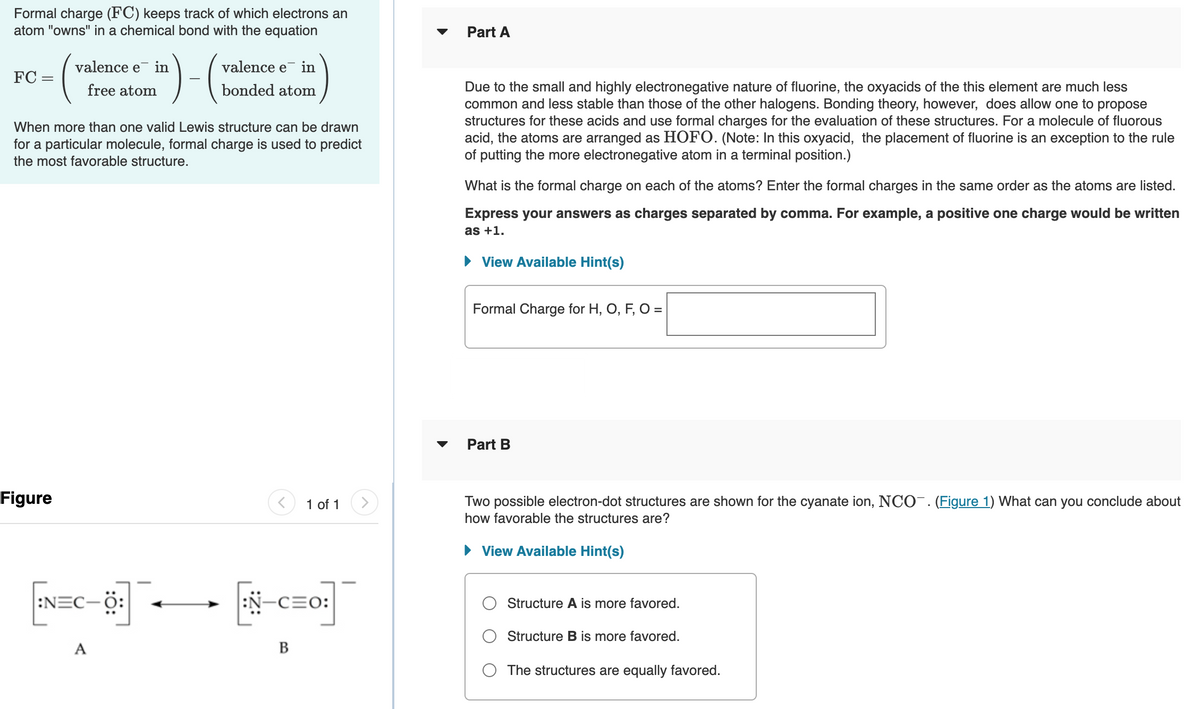Due to the small and highly electronegative nature of fluorine, the oxyacids of the this element are much less common and less stable than those of the other halogens. Bonding theory, however, does allow one to propose structures for these acids and use formal charges for the evaluation of these structures. For a molecule of fluorous acid, the atoms are arranged as HOFO. (Note: In this oxyacid, the placement of fluorine is an exception to the rule of putting the more electronegative atom in a terminal position.) What is the formal charge on each of the atoms? Enter the formal charges in the same order as the atoms are listed. Express your answers as charges separated by comma. For example, a positive one charge would be written as +1. • View Available Hint(s) Formal Charge for H, O, F, O = |
Due to the small and highly electronegative nature of fluorine, the oxyacids of the this element are much less common and less stable than those of the other halogens. Bonding theory, however, does allow one to propose structures for these acids and use formal charges for the evaluation of these structures. For a molecule of fluorous acid, the atoms are arranged as HOFO. (Note: In this oxyacid, the placement of fluorine is an exception to the rule of putting the more electronegative atom in a terminal position.) What is the formal charge on each of the atoms? Enter the formal charges in the same order as the atoms are listed. Express your answers as charges separated by comma. For example, a positive one charge would be written as +1. • View Available Hint(s) Formal Charge for H, O, F, O = |
Organic Chemistry: A Guided Inquiry
2nd Edition
ISBN:9780618974122
Author:Andrei Straumanis
Publisher:Andrei Straumanis
Chapter2: Lewis Structures
Section: Chapter Questions
Problem 12CTQ
Related questions
Question
Please answer question 6 part A and B

Transcribed Image Text:Formal charge (FC) keeps track of which electrons an
atom "owns" in a chemical bond with the equation
Part A
valence e
in
valence e in
FC =
Due to the small and highly electronegative nature of fluorine, the oxyacids of the this element are much less
common and less stable than those of the other halogens. Bonding theory, however, does allow one to propose
structures for these acids and use formal charges for the evaluation of these structures. For a molecule of fluorous
acid, the atoms are arranged as HOFO. (Note: In this oxyacid, the placement of fluorine is an exception to the rule
of putting the more electronegative atom in a terminal position.)
free atom
bonded atom
When more than one valid Lewis structure can be drawn
for a particular molecule, formal charge is used to predict
the most favorable structure.
What is the formal charge on each of the atoms? Enter the formal charges in the same order as the atoms are listed.
Express your answers as charges separated by comma. For example, a positive one charge would be written
as +1.
• View Available Hint(s)
Formal Charge for H, O, F, O =
Part B
Figure
1 of 1
Two possible electron-dot structures are shown for the cyanate ion, NCO¯. (Figure 1) What can you conclude about
how favorable the structures are?
• View Available Hint(s)
:NEC-Ö:
:N-c=0:
Structure A is more favored.
Structure B is more favored.
А
В
The structures are equally favored.
Expert Solution
This question has been solved!
Explore an expertly crafted, step-by-step solution for a thorough understanding of key concepts.
This is a popular solution!
Trending now
This is a popular solution!
Step by step
Solved in 4 steps with 2 images

Recommended textbooks for you

Organic Chemistry: A Guided Inquiry
Chemistry
ISBN:
9780618974122
Author:
Andrei Straumanis
Publisher:
Cengage Learning

Principles of Modern Chemistry
Chemistry
ISBN:
9781305079113
Author:
David W. Oxtoby, H. Pat Gillis, Laurie J. Butler
Publisher:
Cengage Learning

Chemistry: Matter and Change
Chemistry
ISBN:
9780078746376
Author:
Dinah Zike, Laurel Dingrando, Nicholas Hainen, Cheryl Wistrom
Publisher:
Glencoe/McGraw-Hill School Pub Co

Organic Chemistry: A Guided Inquiry
Chemistry
ISBN:
9780618974122
Author:
Andrei Straumanis
Publisher:
Cengage Learning

Principles of Modern Chemistry
Chemistry
ISBN:
9781305079113
Author:
David W. Oxtoby, H. Pat Gillis, Laurie J. Butler
Publisher:
Cengage Learning

Chemistry: Matter and Change
Chemistry
ISBN:
9780078746376
Author:
Dinah Zike, Laurel Dingrando, Nicholas Hainen, Cheryl Wistrom
Publisher:
Glencoe/McGraw-Hill School Pub Co
